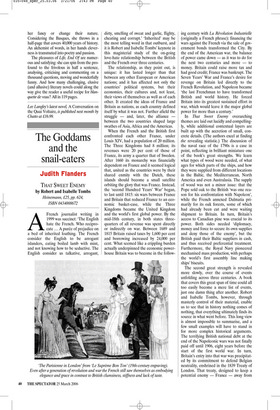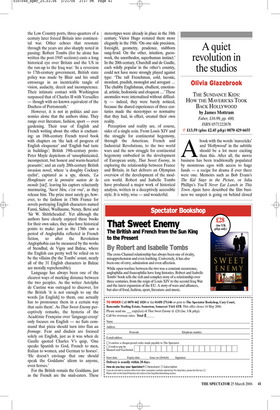The Goddams and the snail-eaters
Judith Flanders
THAT SWEET ENEMY by Robert and Isabelle Tombs Heinemann, £25, pp. 624, ISBN 0434008672 AFrench journalist writing in 1999 was succinct: ‘The English hate the French. Who reciprocate ... A purée of prejudice on a bed of inherited loathing. The French consider the English to be arrogant islanders, eating boiled lamb with mint, and not knowing how to be seductive. The English consider us talkative, arrogant, dirty, smelling of sweat and garlic, flighty, cheating and corrupt.’ ‘Inherited’ may be the most telling word in that outburst, and it is Robert and Isabelle Tombs’ keynote in this magisterial study of the on-going love-hate relationship between the British and the French over three centuries.
The relationship, as they point out, is unique: it has lasted longer than that between any other European or American nations; and it has affected not only the countries’ political systems, but their economies, their cultures and, not least, their views of themselves as well as of each other. It created the ideas of France and Britain as nations, as each country defined itself by what it was not. Further afield the struggle — and, later, the alliance between the two countries shaped large swathes of Asia, Africa and the Americas.
When the French and the British first confronted each other France, under Louis XIV, had a population of 20 million. The Three Kingdoms had 8 million; its revenues were 20 per cent of those of France, its army a quarter that of Sweden. After 1660 its monarchy was financially dependent on France and it seemed logical that, united as the countries were by their shared enmity with the Dutch, these islands should become a small satellite orbiting the glory that was France. Instead, the ‘second Hundred Years’ War’ began, to last until 1815: six wars between France and Britain that reduced France to an economic basket-case, while the Three Kingdoms became the United Kingdom and the world’s first global power. By the mid-18th century, in both states threequarters of all revenue was spent directly or indirectly on war. Between 1689 and 1815 Britain raised taxes by 1,600 per cent and borrowing increased by 24,000 per cent. What seemed like a crippling burden actually underpinned the economic powerhouse Britain was to become in the follow ing century with La Révolution Industrielle (originally a French phrase): financing the wars against the French via the sale of government bonds transformed the City. By the end of the American war, the balance of power came down — as it was to do for the next two centuries and more — to money. Britain could raise more tax and had good credit; France was bankrupt. The Seven Years’ War and France’s desire for revenge on Britain led directly to the French Revolution, and Napoleon became ‘the last Frenchman to have transformed British and world history. He forced Britain into its greatest sustained effort in war, which would leave it the major global power for more than a century.’ In That Sweet Enemy overarching themes are laid out lucidly and compellingly, while additional contextual layers are built up with the accretion of small, concrete details. (The authors excel at finding the revealing statistic.) The discussion of the naval race of the 1790s is a case in point, reflecting in brilliant miniature one of the book’s great strengths. We learn what types of wood were needed, of what ages for which parts of the ships, and how they were supplied from different locations in the Baltic, the Mediterranean, North America and even Australasia. The supply of wood was not a minor issue: that the Pope sold oak to the British ‘was one reason for his confrontation with Napoleon’, while the French annexed Dalmatia primarily for its oak forests, some of which had already been cut and were waiting shipment to Britain. In turn, Britain’s access to Canadian pine was crucial to its power. Both sides needed ‘diplomacy, money and force to secure its own supplies and deny those of the enemy’, but the British paid their Baltic suppliers in cash, and thus received preferential treatment. Furthermore, the Royal Navy pioneered mechanised mass production, with perhaps the world’s first assembly line making ships’ biscuits.
The second great strength is revealed more slowly, over the course of events unfolding across three centuries. A book that covers this great span of time could all too easily become a mere list of events, just one damn thing after another. Robert and Isabelle Tombs, however, through masterly control of their material, enable us to see that in history nothing comes of nothing, that everything ultimately finds its source in what went before. This long view is almost impossible to summarise, and a few small examples will have to stand in for more complex historical arguments. The terrifying British national debt at the end of the Napoleonic wars was not finally paid off until 1906, eight years before the start of the first world war. In turn, Britain’s entry into that war was precipitated by its commitment to defend Belgian neutrality, enshrined in the 1839 Treaty of London. That treaty, designed to keep a potential enemy — France — away from the Low Country ports, three-quarters of a century later forced Britain into continental war. Other echoes that resonate through the years are also sharply noted in passing: Robert Tombs (for he alone has written the post-1945 sections) casts a long historical eye over Britain and the US in the run-up to the Iraq war: ‘In a reversion to 17th-century government, British state policy was made by Blair and his small entourage in an inextricable tangle of vision, audacity, deceit and incompetence. Their intimate contact with Washington surpassed that of Charles II with Versailles — though with no known equivalent of the Duchess of Portsmouth.’ However, it is not in politics and economics alone that the authors shine. They range over literature, fashion, sport — even gardening. Their tour of English and French writing about the other is enchanting: an 18th-century French travel book with chapters on ‘the lack of progress of English eloquence’ and ‘English bad taste in buildings’; British 19th-century protoPeter Mayle depictions of ‘unsophisticated, incompetent, but honest and warm-hearted peasants’; and an early 20th-century British invasion novel, where ‘a doughty Cockney cyclist’, captured as a spy, shouts, ‘La Hongletaire est la première nation de la monde [sic]’, leaving his captors reluctantly murmuring, ‘Sacré bleu, c’est vrai’, as they release him. The prize must surely go, however, to the fashion in 1760s France for novels portraying English characters named Fanni, Sidnei, Wuillaume, Nency, Betsi and ‘Sir W. Shittleheaded’. Yet although the authors have clearly enjoyed these books for their own sakes, they also have historical points to make: just as the 1760s saw a period of Anglophilia reflected in French fiction, so after the Revolution Anglophobia can be measured by the works of Stendhal, de Vigny and Balzac, where the English can pretty well be relied on to be the villains (by the Tombs’ count, nearly all of the 31 English characters in Balzac are morally reprehensible).
Language has always been one of the clearest ways of marking distance between the two peoples. As the writer Astolphe de Custine was outraged to discover, for the British ‘it is not enough to say the words [in English] to them, one actually has to pronounce them in a certain way that suits them’. As That Sweet Enemy perceptively remarks, the hysteria of the Académie Française over ‘language-creep’ only focuses on English — no fiats command that pizza should turn into flan au fromage. Fear and disdain are focused solely on English, just as it was when de Gaulle quoted Charles V’s quip, ‘One speaks Spanish to God, French to men, Italian to women, and German to horses’. ‘He doesn’t envisage that one should speak the Goddams’ idiom to anyone, even horses.’ For the British remain the Goddams, just as the French are the snail-eaters. These stereotypes were already in place in the 18th century; Victor Hugo restated them more elegantly in the 19th: ‘On one side precision, foresight, geometry, prudence, stubborn sang-froid. On the other, intuition, guesswork, the unorthodox, superhuman instinct.’ In the 20th century, Churchill and de Gaulle, each wildly popular in the other’s country, could not have more strongly played against type: ‘The tall Frenchman, cold, laconic, mordant, prudish, monoglot and arrogant ... The chubby Englishman, ebullient, emotional, artistic, hedonistic and eloquent ...’ These anomalies were internalised without difficulty — indeed, they were barely noticed, because the shared experiences of three centuries made the stereotypes so normative that they had, in effect, created their own reality.
Perception and reality are, of course, sides of a single coin. From Louis XIV and the struggle for continental hegemony, through the American, French and Industrial Revolutions, to the two world wars and the new struggle for continental hegemony embodied in the development of European unity, That Sweet Enemy, in exploring the relationship between France and Britain, in fact delivers an Olympian overview of the development of the modern world. Robert and Isabelle Tombs have produced a major work of historical analysis, written in a deceptively accessible style. It is witty, wise — and wonderful.
























































 Previous page
Previous page